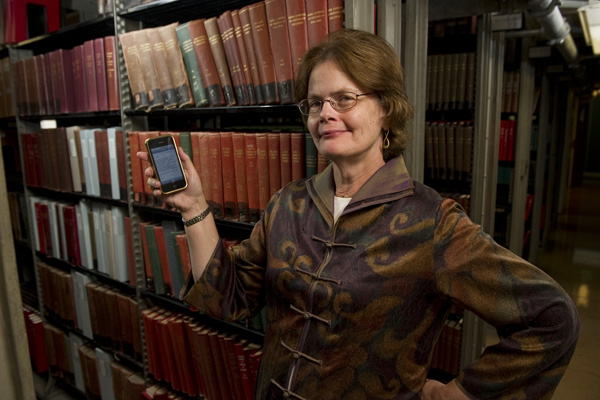June 21, 2010
Envisioning Welch Library of the future

Nancy Roderer says that telephones and computers will give users access to the information they once gleaned from the Welch Library’s physical collection. Photo: Will Kirk/Homewoodphoto.jhu.edu
In 2001, the Welch Medical Library leadership posed a determining question to its staff and customer base: What will the library and its services be like in 2012?
Realizing innovation is essential in the information business, the library wanted to be two steps ahead.
What was envisioned by respondents was a “virtual library” where, from any remote site, a visitor could peruse the institution’s full catalog, interact with librarians and conduct research.
In other words, a central service point and deep rows of book stacks would no longer be needed.
Nancy K. Roderer, director of the Welch Medical Library and of the Johns Hopkins Division of Health Sciences Informatics, said that the library has been inching closer to that reality ever since and in the coming year will commence a series of initiatives to further decrease its physical presence and enhance its cyber one.
“At some point, everything is going to be available electronically in medicine, and how do we want our services to work then?” Roderer said. “A new model of librarianship is called for. How do you shut down the old and usher in the new? That is what we’ve been diligently working on.”
Welch services the schools of Medicine, Nursing and Public Health, The Johns Hopkins Hospital and the Kennedy Krieger Institute, which together have an estimated customer base of 30,000. In addition to its main branch at 1900 E. Monument St., the library has four satellite locations on the East Baltimore campus. The main branch is named for the School of Medicine’s first dean, William H. Welch, honoring his role in the library’s creation and the founding of the Institute of the History of Medicine, located on the building’s third floor.
Its first year, the library had eight staff members and total holdings that amounted to 79,264 volumes. Today, the library has a staff of 60 and its print collections contain more than 400,000 bound volumes. Its electronic journals are extensive and include approximately 30,000 e-journals, 400 databases and 1,000 e-books. The collection covers health, the practice of medicine, nursing, research literature, methodological literature and in-depth analyses of areas influencing biomedicine and health care.
Roderer said that the physical collection, which has been decreasing, will continue to do so. Many print items now available in electronic form will be removed from the building and recycled by 2012. Small collections of print reserve materials will be relocated to student spaces. In the future, fewer paper items will be added, she said, as 98 percent of the collection budget goes to electronic materials.
In 2004, the Population Center Library, a Welch satellite, was converted into a service point, a small space that can be used by library staff when they are working with people in a department. (Another service point exists in the Armstrong Medical Education Building.) The former Meyer satellite library was closed in 2009. By the end of 2010, Welch will end its presence in what is now the Lilienfeld Library, a full-service satellite in Hampton House that serves primarily the Bloomberg School of Public Health.
In the future, Welch might add more service points, but as library services become increasingly virtual, Roderer envisions a day when there will be no physical service spaces and administrative offices will move elsewhere.
Were this to happen, the Welch Library building would continue to house the Institute of the History of Medicine and its Historical Collection, and the West Reading Room, which is home to John Singer Sergeant’s The Four Doctors painting, which depicts the founders of the School of Medicine.
To help its users access electronic materials more efficiently, Welch will develop new websites and tools and continue to tweak its Web presence.
“We want to make it really easy for our patrons to find the answers they need,” Roderer said. “Faculty are more apt to e-mail librarians these days than visit the branch.”
A number of enhancements have already been implemented, such as departmental portals, a search function that gives users the ability to comb multiple journals and databases at one time and the creation of a personalized interface called “MyWelch.”
Roderer said that Welch will launch a new version of its home page in the coming months.
To continue to provide the services of librarians to its users, Welch has gradually initiated a program of “informationists,” librarians who work closely with specific departments. There are currently 10 informationists serving more than 100 departments and other units. In the fall, a campuswide survey will be conducted to get a closer read on user needs and how this group foresees interacting with the library and its staff moving forward.
“We want to find a way to serve the greatest number of faculty, students and staff more efficiently and effectively,” Roderer said.
David Nichols, vice dean for education at the School of Medicine and chair of the Welch Library Advisory Committee, said that the library has been at the forefront of innovation in its field.
“Welch has a truly outstanding virtual presence with an ease of navigation and richness of tools. It’s just tremendous,” Nichols said. “Nancy and the library have done a really terrific job positioning us to where we are now.”
Roderer said that Welch and Johns Hopkins are not alone in its efforts.
“Other medical libraries are going through a version of what we’re doing, reducing physical collections and moving services out to the users, but we have had some recognition as having done more of it faster,” she said.
With more to come.

